
Trafikle ilgili anahtar kelimelere genel bakış. Burada henüz bilmediğiniz anahtar kelimeleri ve tanımları kolayca arayabilirsiniz.
More subjects
The Smooth Fox Terrier is a breed of dog, one of many terrier breeds. It was the first breed in the fox terrier family to be given official recognition by The Kennel Club (circa 1875; breed standard 1876). It is well known, and although not a widely popular breed today outside hunting and show circles, it is extremely significant due to the large number of terriers believed descended from the breed. The Smooth Fox Terrier is a highly energetic dog, and thus not recommended for first time dog owners. As the breed was originally bred to go after small animals, they also have a high prey instinct, they are very friendly dogs and do not mind strangers if introduced and exposed to people from a young age. Without appropriate early exposure, however, loud barking may ensue. (Source: Wikipedia.org, CC BY-SA)
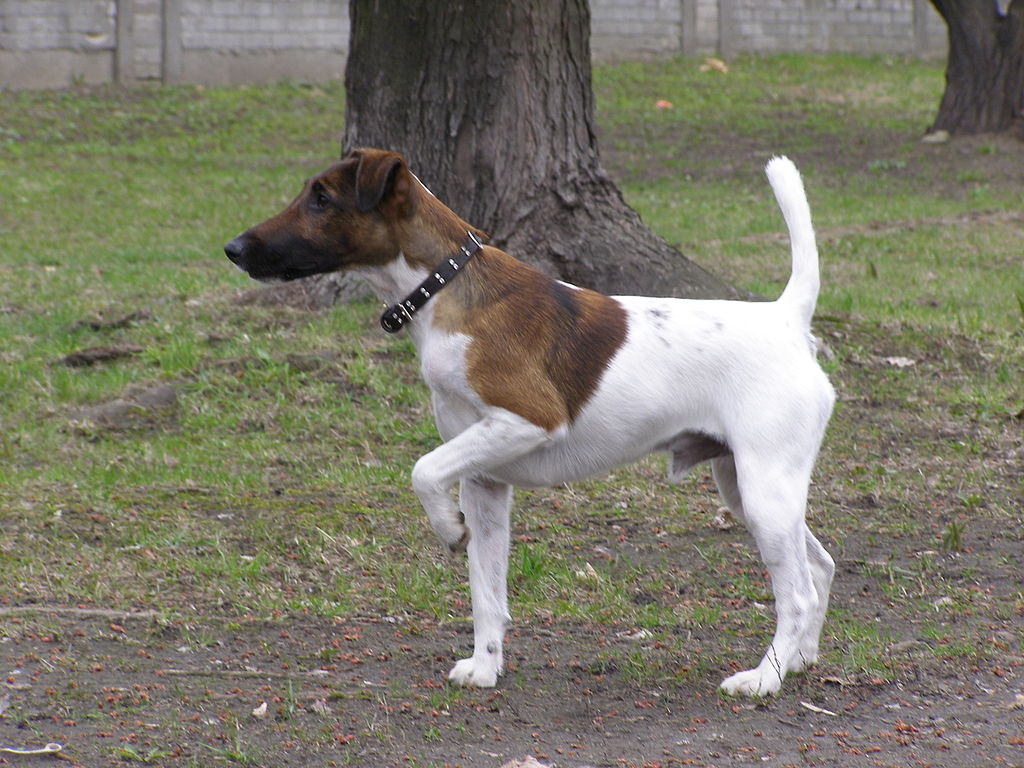 © Wikimedia.org/Piotr Pietryka, CC BY-SA
© Wikimedia.org/Piotr Pietryka, CC BY-SA
The Soft-coated Wheaten Terrier (Irish: An Brocaire Buí - literally, 'Yellow Terrier') is a pure-breed terrier originating from Ireland. Wheatens typically have one of two coat types: Irish or Heavy (American). The Irish coat is generally silkier and wavier than the Heavy, or American coat, which is thicker and fuller. Wheatens are generally friendly and playful, and tend to get along well with children and other dogs. (Source: Wikipedia.org, CC BY-SA)
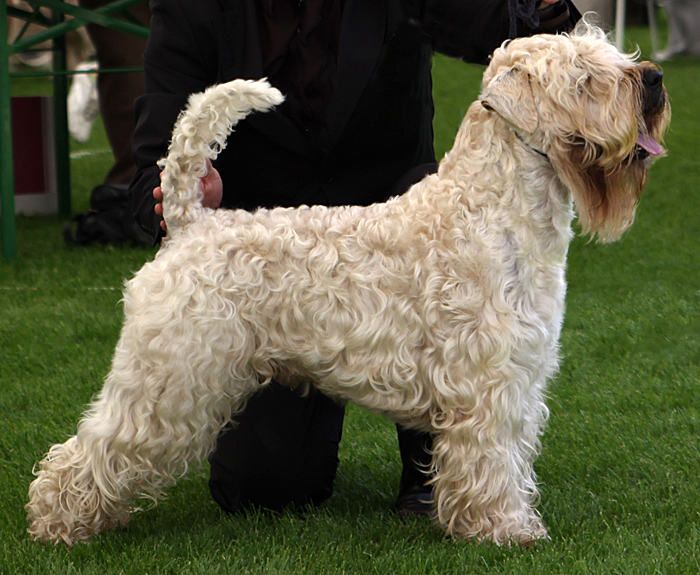 © Wikimedia.org/Terrierkännaren, CC BY-SA
© Wikimedia.org/Terrierkännaren, CC BY-SA
The South Russian Ovcharka or South Russian Shepherd Dog is breed of flock guardian dog developed in the Russian Empire and in the Soviet Union. It is thought to derive from cross-breeding between local dogs of the Russian steppes and long-haired shepherd dogs brought to the area from Spain with Merino sheep. These may have been similar in appearance to the present-day Gos d'Atura Catala. It is a large dog: dogs stand no less that 66 cm at the withers and weigh at least 35 kg; bitches are about 4 cm smaller and weigh some 5 kg less. The head is long and of wedge shape; the ears are pendent and triangular. The coat is long, coarse and thick. It may be solid white, grey or pale ivory; or white with tinges of yellow, or white with patches of grey, pale ivory or wheat colour. (Source: Wikipedia.org, CC BY-SA)
The Spanish Mastiff or Mastín Español is a breed of dog from Spain, originally bred to be a guard dog and whose specialized purpose is to be a livestock guardian dog protecting flocks and/or herds from wolves and other predators. The Spanish Mastiff is a very large and powerful dog, similar in appearance to the other mastiff breeds. They have a large powerful head and serious and vigilant expression. Males in this breed are 70 to 85 centimetres (28 to 33 in) tall at the withers, and range from 50 to 70 kilograms (110 to 150 lb). Females are at least 65 centimetres (26 in), and weigh 40 to 60 kilograms (88 to 132 lb). It has small eyes and drop ears resembling triangles. This dog's coat is most often fawn, but it can also be brindle, black or 'wolf'-colored. Reddish tones indicate miscegenation. (Source: Wikipedia.org, CC BY-SA)
The Spanish Water Dog (perro de agua español) breed is used in Spain as a general purpose sheepdog and guard. It is also used sometimes as a gundog, and is skilled at retrieval from water. The SWD is a medium size, athletic, robust dog that is slightly longer than tall. Approximately half are born with natural bobbed (short) tails. Long tailed dogs are usually docked in the US, but undocked tails are not a fault in conformation showing if the dog was bred in a non-docking country. The SWD is diligent, loyal, affectionate, and intelligent. They have very strong natural herding and guarding instincts, leading them to become the 'self-appointed' guardians of their homes. SWDs thrive on work and play. Their athleticism and extremely hard working nature leads them to excel at any number of tasks. They can be wary with strangers, and early and continuing socialization with a variety of people and other animals is essential for a well-adjusted, social dog. Good socialization at an early age greatly helps them cohabit with small children. (Source: Wikipedia.org, CC BY-SA)
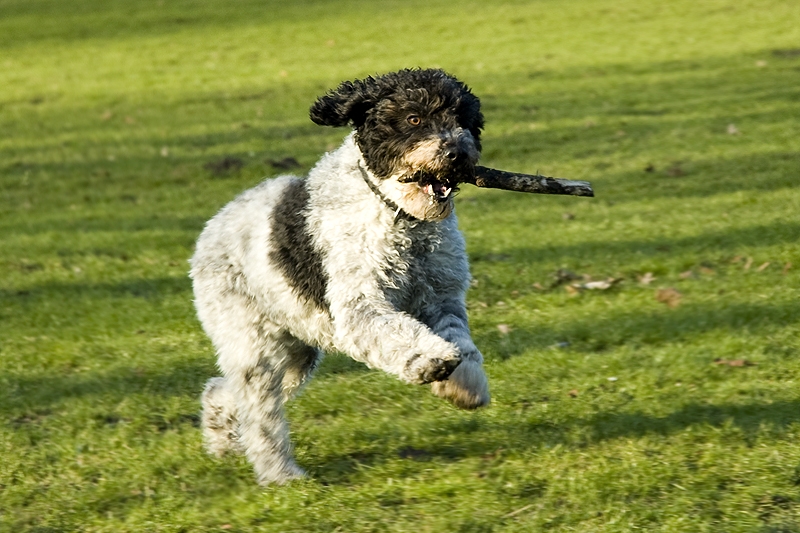 © Wikimedia.org/Marius Marker, CC BY-SA
© Wikimedia.org/Marius Marker, CC BY-SA
The Spinone Italiano is an Italian breed of hunting dog, traditionally used for tracking, for pointing and for retrieving game. The Spinone is roughly square in outline when seen from the side – the length of the body is approximately equal to the height at the withers. It is a strong, well-muscled and solidly-built suitable for hunting over any kind of ground. It swims well and enters cold or deep water without hesitation. The coat is rough, thick and flat, with little undercoat; it is about 4 to 6 cm (1.5 to 2.5 in) long, rather shorter on the head, feet and front of the legs. Hair on the eyebrows and lips is longer and stiffer, thus forming a thick moustache and beard. It may be: solid white; white with orange speckling or markings; white with chestnut brown markings; or brown or orange roan. (Source: Wikipedia.org, CC BY-SA)
The Sporting Lucas Terrier is a small breed of dog of the terrier type. The breed is named for Jocelyn Lucas. A short-legged working terrier that must be small and narrow enough in the chest to go to ground when required. About twelve inches at the withers, and about 15 lbs. in weight. The harsh shaggy coat is white with dark patches, or various combinations of brown, black and tan or grizzle and tan. (Source: Wikipedia.org, CC BY-SA)
The Stabyhoun, or Stabijhoun or Stabij (in Frisian), is one of the rarest dog breeds in the world. It hails from the Dutch province of Friesland; its origins lie in the forested region of eastern and southeastern Friesland. The breed has been mentioned in Dutch literature dating back to the early 1800s, but it was not until the 1960s that the breed became known outside its native province; the first Stabyhouns left the Netherlands some decades later, in the 2000s. The name Stabijhoun translates roughly to 'stand by [me] dog'. The dog is considered a Dutch national treasure. Today, there are only a few thousand Stabyhouns worldwide. (Source: Wikipedia.org, CC BY-SA)
The Staffordshire Bull Terrier, also called the Staffy or Stafford, is a purebred dog of small to medium size in the terrier group that originated in the northern parts of Birmingham and in the Black Country of Staffordshire, for which it is named. They descended from 19th century bull terriers that were developed by crossing bulldogs with various terriers to create a generic type of dog generally known as bull and terriers. Staffords share the same ancestry with the modern Bull Terrier, although the two breeds developed along independent lines, and do not resemble each other. Modern Staffords more closely resemble the old type of bull terrier, and was first recognised as a purebred dog breed by The Kennel Club of Great Britain in 1935. (Source: Wikipedia.org, CC BY-SA)
The Schnauzer or Mittelschnauzer is a German breed of dog in the Pinscher and Schnauzer group. It is characterised by an abundant bristly beard and moustache, usually lighter than the coat. It is one of three Schnauzer breeds, the others being the Giant Schnauzer or Riesenschnauzer, and the Miniature Schnauzer or Zwergschnauzer. In Germany it is an endangered breed, and is listed in category III of the Rote Liste of the Gesellschaft zur Erhaltung alter und gefährdeter Haustierrassen. The Schnauzer is a robust and squarely-built dog of medium size, of working or utility type. The coat is hard, wiry and dense, with a thick soft under-coat. It may be salt-and-pepper or black; in the salt-and-pepper, the grey may vary from pale silver-grey to dark iron-grey. Salt-and-pepper dogs have a black mask. The ears are set high and drooping; the eyes are dark. (Source: Wikipedia.org, CC BY-SA)
The Stumpy Tailed Heeler is a naturally bobtailed or tailless, medium-sized cattle dog similar and/or related to the Australian Cattle Dog (aka, 'Blue/Red Heeler'). The Australian Stumpy Tail Cattle Dog was developed in Australia to herd cattle, and descends from crosses between European herding dogs and the Australian dingo. The name is spelled both with hyphenation, and without, and while the shorter name Heeler is sometimes applied, the name Heeler most often refers to the Australian Cattle Dog . The ideal temperament of the Heeler is described in the breed standard as alert and watchful, as well as responsive to its owner and reserved around strangers, but also notes that 'it must be amenable to handling' at shows. All working dogs need early socialisation with people, and consistent training and activity throughout their lives. (Source: Wikipedia.org, CC BY-SA)
The Styrian Coarse-haired Hound (German: Steirische Rauhhaarbracke) is a breed of medium-sized hound dog originated in the Austrian province of Styria. It is bred as a scenthound, for hunting boar in mountainous terrain. The breed is one of the large Austrian Bracke. The Styrian Coarse-haired Hound is a medium-sized hound, with height at the withers of 45–53 cm (17.5–21 in), and weight between 15–18 kg (33-40 lbs) with a well muscled body and a serious expression. The breed name refers to the coat, which is harsh and rough (although not shaggy). Coat colours are red and fawn; a white mark on the chest may be present. The breed tolerates extremes of temperature well, and has remained a healthy breed through 'refresher breeding' (Auffrischungszucht, outcrossing). (Source: Wikipedia.org, CC BY-SA)
The Sussex Spaniel is a breed of dog native to Sussex in southern England. It is a low, compact spaniel and is as old a breed as and similar in appearance to the Clumber Spaniel. They can be slow-paced, but can have a clownish and energetic temperament. They suffer from health conditions common to spaniels and some large dogs, as well as a specific range of heart conditions and spinal disc herniation. The Sussex Spaniel is a low compact spaniel similar in appearance, but not in colour, to a Clumber Spaniel. It is normally no taller than 15–16 in (38–41 cm) at the withers and the usual weight range is 45–50 lb (20–23 kg) with a roughly rectangular appearance. The Clumber Spaniel meanwhile is normally between 17–20 in (43–51 cm) high at the shoulder, and weighing 55–85 lb (25–39 kg). (Source: Wikipedia.org, CC BY-SA)
The Swedish Lapphund (Swedish: Svensk lapphund) is a breed of dog of the Spitz type from Sweden, one of three Lapphund breeds developed from a type of dog used by the Sami people for herding and guarding their reindeer. The expression 'the black beauty of Norrland' is very often attributed to the Swedish lapphund, which is most likely one of Sweden's oldest breeds. Like all spitz dogs in general, the Swedish lapphund demands a stable upbringing and both regular mental and physical stimulation to perform at its best. As a working dog they show their versatility in a number of different fields. Many compete with success in such widely different disciplines as obedience, dog agility trials, working contest, freestyle/heelwork to music, Rally obedience, and blood tracking. The Swedish Lapphund can also participate in herding events. Herding instincts and trainability can be measured at noncompetitive herding tests. Lapphunds exhibiting basic herding instincts can be trained to compete in herding trials. (Source: Wikipedia.org, CC BY-SA)
The Swedish Vallhund, also known as the Västgötaspets and Swedish cow dog, is a breed of dog native to Sweden. The breed's name, Vallhund, when translated into English, means herding dog, as the Swedish Vallhund was originally bred as a drover and herder of cows over 1,000 years ago. In 1942, the dog came close to extinction, but careful breeding and publicity by Swedish national Bjorn von Rosen and K. G. Zettersten managed to revive the breed in popularity and save it from its likely end. In 1943, the Swedish Kennel Club recognized the Swedish Vallhund as a breed, and officially categorized the Swedish Vallhund as 'the Västgötaspets' for Västergötland, the province in which their revival took place. Since then, the breed has been recognized by, and bred in, over ten countries and has gained some popularity. (Source: Wikipedia.org, CC BY-SA)
The Taigan (Kyrgyz: тайган), and also known as Kyrgyz Taighany (Kyrgyz: кыргыз тайганы) (Kyrgyzskaya Borzaya in Russian), is a breed of sighthound from Kyrgyzstan. The Taigan is found in the alpine Tian Shan region of Kyrgyzstan on the border with China, it is closely related to the Tazy and the Afghan hound. As a sighthound, the Taigan predominantly uses its sight and speed to overcome its prey. The breed is known for its extraordinary stamina at altitude, and its versatility whilst hunting. They are capable of following scent trails and also have a reputation for retrieving game. Taigans are often used to hunt in combination with trained bird of prey, especially the golden eagle. The Taigan is used to hunt a wide range game including marmot, hare, fox, badger, wildcat, hoofed game such as the ibex and roe deer as well as the wolf. (Source: Wikipedia.org, CC BY-SA)
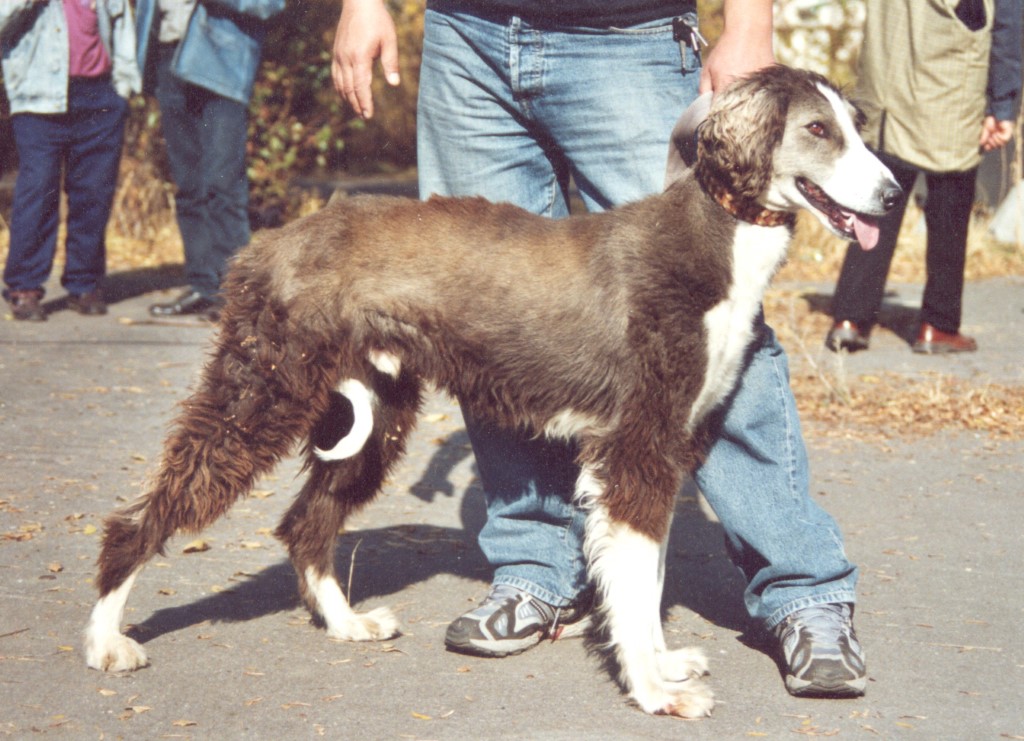 © Wikimedia.org/Jan Scotland, CC0
© Wikimedia.org/Jan Scotland, CC0
The Taiwan Dog (Chinese: 台灣犬) is a breed of small or medium dog indigenous to Taiwan. These dogs are also known as the Formosan Mountain Dog. They are well-adapted to the uneven and thickly forested terrain of Taiwan, having become a semi-wild breed prior to the arrival of several colonial reigns and foreign powers. Notwithstanding these adaptations, Formosans retained the potential to be trained and are now used as hunting dogs, guard dogs, stunt dogs, rescue dogs, or simply as companions. Formosans are classified into one medium type and two small types. (Source: Wikipedia.org, CC BY-SA)
 © Wikimedia.org/KatieHuang, CC BY-SA
© Wikimedia.org/KatieHuang, CC BY-SA
The Tatra Shepherd Dog, Polish: Polski Owczarek Podhalański, is a Polish breed of large flock guardian dog originating in the Tatra Mountains of the Podhale region of southern Poland. It was fully recognised by the Fédération Cynologique Internationale in 1963. It is one of five dog breeds originating in Poland, the others being the Polish Greyhound, the Polish Hound, the Polish Hunting Dog and the Polish Lowland Sheepdog. The height at the withers is 65 to 70 centimetres (26 to 28 in) for males, 60 to 65 centimetres (24 to 26 in) for bitches.They usually live for between ten and twelve years. (Source: Wikipedia.org, CC BY-SA)
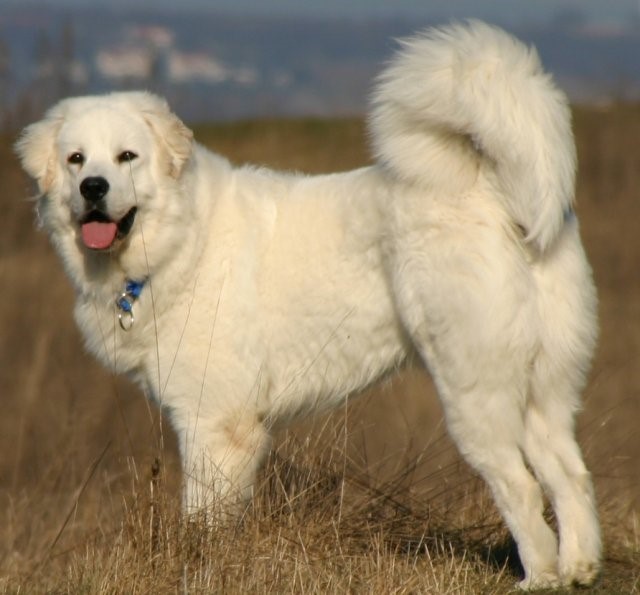 © Wikimedia.org/Svenfischer, CC BY-SA
© Wikimedia.org/Svenfischer, CC BY-SA
Tazy is a breed of sighthound hunting dog originating from Kazakhstan. Though it looks similar to Saluki sighthound, it is a different dog breed. Tazys are medium-sized, deep-chested, and long-legged dogs, with short length hair on the body and longer hair on the tail and ears. Tazys tend to be independent and aloof to strangers. The Tazy is known for their playfulness, endurance, and vigilance. Tazys can run long distances at speeds of 12-15 kilometers (7–9 miles) per hour. (Source: Wikipedia.org, CC BY-SA)
The Teddy Roosevelt Terrier is a small to medium-sized American hunting terrier. It is lower-set, with shorter legs, and is more muscular with heavier bone density than the related American Rat Terrier. Much diversity exists in the history of the Teddy Roosevelt Terrier breed, and it shares a common early history with the American Rat Terrier, Fox Paulistinha, and Tenterfield Terrier. The Rat Terrier's background is said to stem from the terriers or other dogs that were brought over by early English and other working-class immigrants. Since the breed was a farm, hunting, and utility dog, little to no planned breeding was used other than breeding dogs with agreeable traits to each other to produce the desired work ethic in the dog. The Feist (dog), Bull Terrier, Smooth Fox Terrier, Manchester Terrier, Whippet, Italian Greyhound, the now extinct English White Terrier, Turnspit Dog, and Wry-legged Terrier all share in the Teddy Roosevelt Terrier's ancestry. These early ratting terriers were then most likely bred to the Beagle or Beagle crossbred dogs (for increased scenting ability) and other dogs. Maximizing the influences from these various breeds provides the modern Teddy Roosevelt Terrier with a keen sense of awareness and prey drive, an acute sense of smell. and a very high intellect. Although they tend to be aloof with strangers, they are devoted companion dogs with a strong desire to please and be near their owners at all times. (Source: Wikipedia.org, CC BY-SA)
The Telomian is a type of dog found in isolated villages near the Telom River in the rainforests of the Malay Peninsula. It has been introduced into the United States. Some US-based breeders were selling these dogs as pure breds, which was dismissed with the Malaysian Kennel Association in a statement that these are pariah dogs and not a breed. These are an active dog that is affectionate towards people, and possess a terrier-like temperament. They feature erect ears, curly tails, with short fur on the coat that is either red or yellow. There may be some variation in coat colour. Some are piebald in colour, and occasionally some have a black mask. (Source: Wikipedia.org, CC BY-SA)
The Tenterfield Terrier is a dog breed developed in Australia. They are a strong, active, hardy and agile dog, their smooth short coat making them 'easy care' family companions. Tenterfield Terriers come in a variety of colours, but their coat colors are mostly white with black, olive or even tan markings in its tones. They are small dogs, on average growing to heights of between 25 and 30 centimeters tall. Tenterfield Terriers are fairly healthy breeds of dog, however they are prone to hypothyroidism and patellar luxation, as well as a tendency to become overweight if fed too often. They are a very intelligent and trainable breed of dog, yet will require consistent training. The Tenterfield Terrier is a high-energy dog that will need to be taken for walks at least daily. Their temperament is friendly if well-taken care of, yet they can become destructive or noisy if bored. Being a terrier, they should not be trusted with non-canine pets such as mice, guinea-pigs, rats, or rabbits. (Source: Wikipedia.org, CC BY-SA)
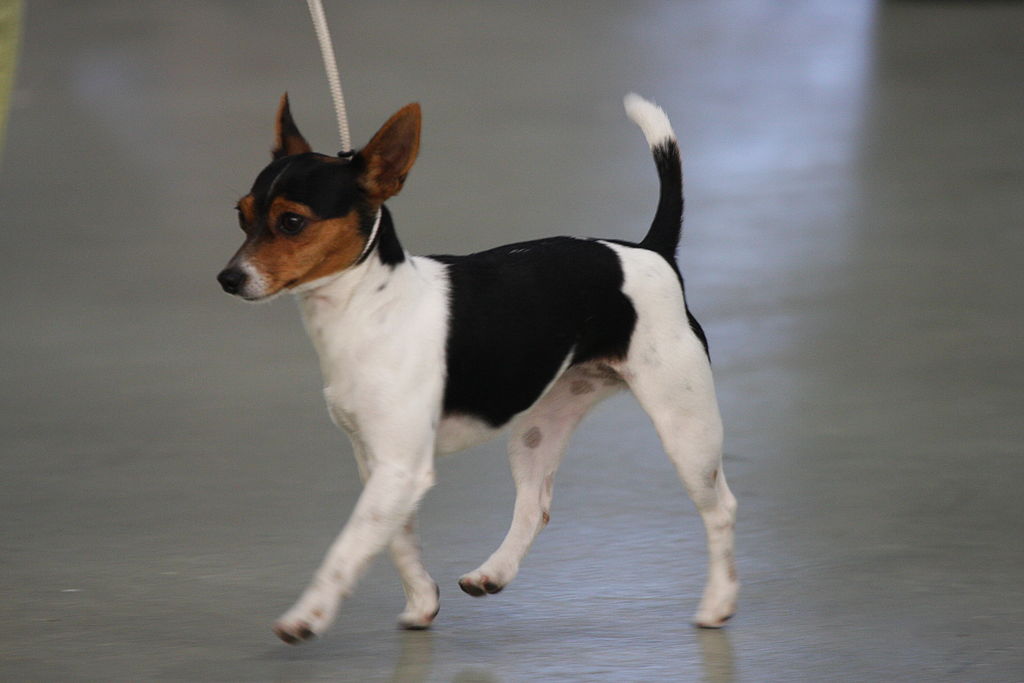 © Wikimedia.org/David Nemirovsky, CC BY-SA
© Wikimedia.org/David Nemirovsky, CC BY-SA
The Thai Bangkaew Dog (Thai: ไทยบางแก้ว) is an Asian dog breed. It is a medium-sized spitz-type dog. The Thai Bangkaew Dog is compactly built and square in profile. It is well proportioned, with a smooth gait. The double coat consists of a short undercoat, with longer guard hairs growing through it forming the outer coat. The coat is thicker and longer around the neck, chest, and back forming a lion-like ruff, which is more noticeable on male dogs than on female dogs. The plumed tail is carried with moderate upward curve over the back. The breed comes in white with shades of red, gray, brown, and black in a wide variety of patterns. There are some that have white coats. (Source: Wikipedia.org, CC BY-SA)
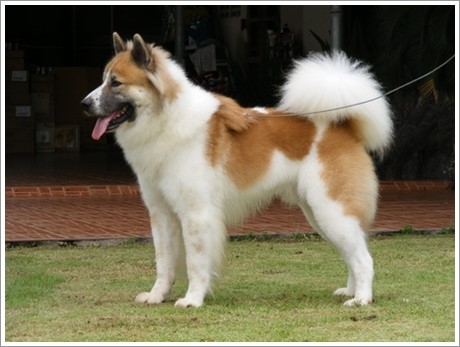 © Wikimedia.org/Noipow, CC BY-SA
© Wikimedia.org/Noipow, CC BY-SA
The Thai Ridgeback (Thai: ไทยหลังอาน, RTGS: Thai Lang-An) is a dog from Thailand. The Thai Ridgeback is one of only three breeds that has a ridge of hair that runs along its back in the opposite direction to the rest of the coat. The other two are the Rhodesian Ridgeback and the Phu Quoc Ridgeback. The Thai Ridgeback is a muscular, medium-sized pariah-type dog with a wedge-shaped head, triangular-shaped prick ears, and a very short, smooth coat. It has a pronounced ridge on its back formed by hair growing in the opposite direction that extends from behind the withers to the hips. Puppies are occasionally born ridgeless. Thai Ridgebacks have a muscular and streamlined body, making them extremely agile. The tail is carried upward called a sickle or sword tail. Its forehead wrinkles with enormous expression. Like many eastern breeds, the Thai Ridgeback has retained a 'scissor jaw' where upper and lower teeth interlock when the jaw bones clamp down. The tongue can be black or have black marks. Eyes are almond-shaped and brown but may be amber in blue dogs. The ears are set low and point slightly outward. (Source: Wikipedia.org, CC BY-SA)
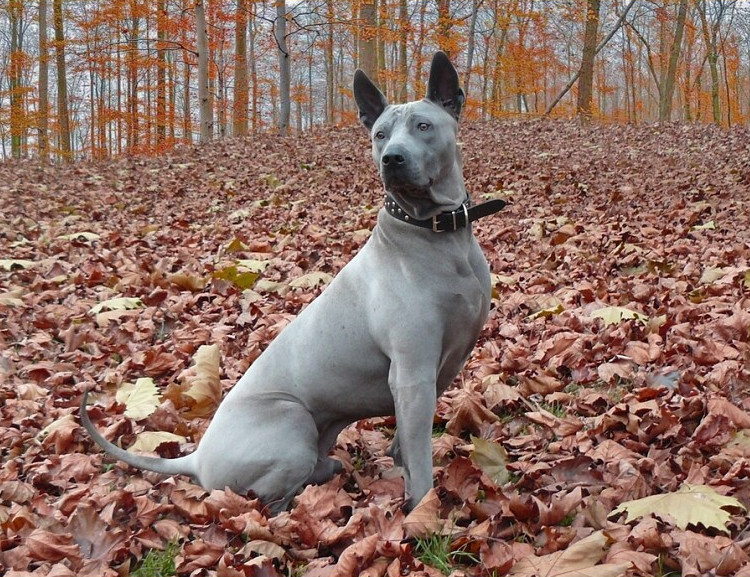 © Wikimedia.org/Plums´Jewel, CC BY-SA
© Wikimedia.org/Plums´Jewel, CC BY-SA
The Tibetan Mastiff (Standard Tibetan: འདོགས་ཁྱི, THL: Do khyi, Wylie: 'dogs khyi) is a large size Tibetan dog breed. Its double coat is medium to long, subject to climate, and found in a wide variety of colors, including solid black, black and tan, various shades of red (from pale gold to deep red) and bluish-gray (dilute black), and sometimes with white markings around neck, chest and legs. The Tibetan Mastiff is considered a primitive breed.[citation needed] It typically retains the hardiness which would be required for it to survive in Tibet, Ladakh and other high-altitude Himalayan regions. (Source: Wikipedia.org, CC BY-SA)
The Tibetan Spaniel is a breed of assertive, small dogs originating in Tibet. This breed is not a spaniel in the original meaning of the term; its breeding differs from other spaniels, and unlike true spaniels, which are gun dogs, the Tibetan spaniel is a companion dog. The spaniel name may have been given due to its resemblance to the bred-down lapdog versions of the hunting spaniels, such as the Cavalier King Charles spaniel. The Tibetan Spaniel has a domed head that is small in comparison to its body. It has a short blunt muzzle, free of wrinkles. Its teeth occlude in either an underbite or an end-to-end bite. The nose is black. The eyes are medium in size, set wide apart, and oval in shape. The Tibetan Spaniel does not have extra skin around the eyes; this helps to distinguish the breed from the Pekingese. (Source: Wikipedia.org, CC BY-SA)
 © Wikimedia.org/Rob Moroto, CC BY-SA
© Wikimedia.org/Rob Moroto, CC BY-SA
The Tibetan Terrier is a medium-sized breed of dog that originated in Tibet. Despite its name, it is not a member of the terrier group. The breed was given its English name by European travelers due to its resemblance to known terrier breeds. The Tibetan name for the breed, Tsang Apso, roughly translates to 'shaggy or bearded ('apso') dog, from the province of Tsang'. Some old travelers' accounts refer to the dog as Dokhi Apso or 'outdoor' Apso, indicating a shaggy or bearded working dog which lives outdoors. The Tibetan Terrier is a powerful, medium-sized dog of square proportions, with a shaggy coat. They vary widely in height and weight, ranging from 14–16 in (35–41 cm) and is 18–30 lb (8–14 kg), with 20–24 lb (9.5–11 kg) preferred for either sex. All weights are acceptable if in proportion to the size. (Source: Wikipedia.org, CC BY-SA)
 © Wikimedia.org/PateraIncus, CC BY-SA
© Wikimedia.org/PateraIncus, CC BY-SA
The Tornjak (pronounced [torɲâk]), is a breed of livestock guardian dog native to Bosnia and Herzegovina and Croatia. The name comes from the local word for a sheep pen, 'tor'. The foundation stock is made up from genetically homogeneous landrace shepherding dogs dispersed in the mountains and valleys of the region. They are molosser-type mountain dogs, similar to other livestock guardian breeds of the region, the Šarplaninac, Bucovina Shepherd Dog, and the Greek Shepherd. The Tornjaks are large dogs, with somewhat square-bodied features and relatively agile movements. In spite of this, their bones are not lightweight. In general, the Tornjak is a long-coated breed with short hair over the face and legs. The hair is distinctively long and abundant over the neck (mane), and on the back of the upper thighs (breeches). The tail is notably feathered and carried like a flag while the dog moves. The coat is very dense and cannot be parted. (Source: Wikipedia.org, CC BY-SA)
The Tosa Inu (土佐, also called the Tosa-Ken and Japanese Mastiff) is a breed of dog of Japanese origin that is considered rare. It was originally bred in Tosa, Shikoku (present day Kōchi) as a fighting dog and is the only breed still used (legally) in Japanese dog fighting. Ownership is restricted in some countries as a dangerous breed. In South Korea it's one of the main dog meat breeds alongside with Nureongi dogs. The Tosa varies considerably in size, with the Japanese-bred dogs tending to be about half the size of those bred outside the country. The Japanese breed generally weighs between 36 and 61 kilograms (80 and 135 lb), while the non-Japanese breeders have focused on dogs that weigh from 60 to 90 kg (130 to 200 lb) and stand 62 to 82 cm (24 to 32 in) at the withers. The coat is characterized by its short and smooth appearance and is often red, brindle or fawn, but occasionally it can be a dull black. Maintenance of the coat is usually minimal. Dogs can occasionally tip the scale at 91 kilograms (200 lb). In Japan they are considered the equivalent of Sumo wrestlers, and are even depicted in wrestling accoutrement. (Source: Wikipedia.org, CC BY-SA)
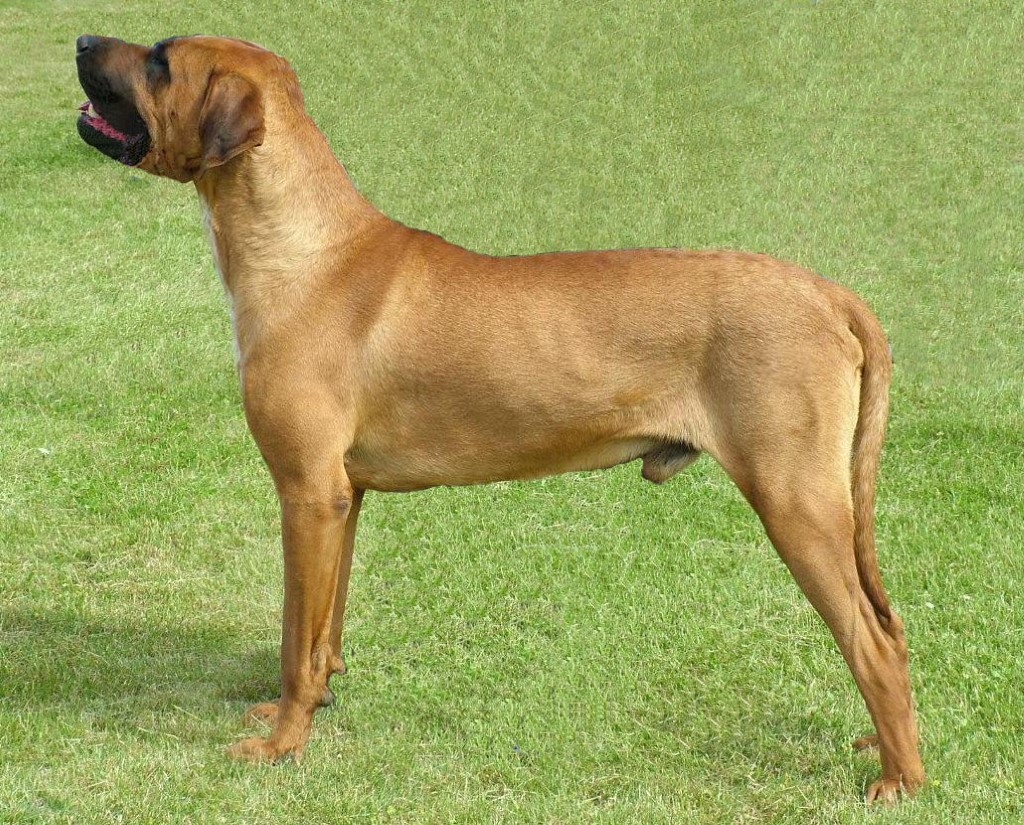 © Wikimedia.org/Ludivine HOUDAS, CC BY-SA
© Wikimedia.org/Ludivine HOUDAS, CC BY-SA
The Toy Fox Terrier is a small terrier breed of dog, directly descended from the larger Smooth Fox Terrier but since 1936, it has been registered in the USA with the UKC as a separate breed. Toy Fox Terriers are small dogs with a muscular and athletic appearance. Notable characteristic traits include a short glossy and predominantly white coat, coupled with a predominantly solid head, and a short, high-set tail. The breed has been deemed elegant and graceful with V-shaped ears and large eyes. The tail can be short and straight or long and shiny, and breeders often shorten the tail a few days after birth by clipping it about three-fifths of the way from the tip (at the third or fourth joint). The coat is short, fine, and glossy in black with tan, with areas of tan on the face. (Source: Wikipedia.org, CC BY-SA)
 © Wikimedia.org/Terry Best, CC BY-SA
© Wikimedia.org/Terry Best, CC BY-SA
The Toy Manchester Terrier is a breed of dog, categorized as a terrier. The breed was bred down in size in North America from the Manchester Terrier, and is placed in the Toy Group by the American Kennel Club and the Canadian Kennel Club (the Manchester Terrier is placed in the Terrier Group). Neither the Fédération Cynologique Internationale nor The Kennel Club recognize a Toy variety of the Manchester Terrier. The Toy Manchester Terrier in North America is a small, long-legged dog with a short coat marked with tan, a long tail and ears which stand upright. In color and general conformation the Toy Manchester Terrier follows the standard for the Manchester Terrier. However, the Toy Manchester Terrier cannot exceed 12 pounds (5.4 kg) in weight. (Source: Wikipedia.org, CC BY-SA)
The Cão de Gado Transmontano or Transmontano Mastiff is a breed of livestock guardian dog from Portugal. It originates in the historical province of Trás-os-Montes e Alto Douro in north-eastern Portugal, and is a rare breed confined mostly to this area. They are first and foremost working livestock guardian dogs, and their development and temperament should be understood and appreciated in that context. This breed has a calm and reserved reaction to threats, and is notably curious and intelligent. An important attribute is its ability to work as a mixed pack with intact males and females; of course, younger males have to socialize to 'temper their dominance' and adapt to working within the pack. They have a natural predisposition toward digging under fences and 'expanding their territory,' which needs to be monitored and controlled. (Source: Wikipedia.org, CC BY-SA)
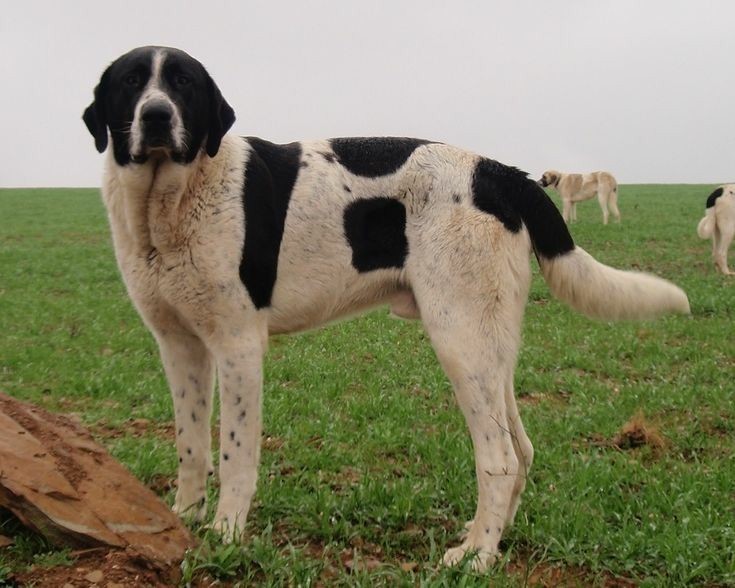 © Wikimedia.org/CARLOS, CC BY-SA
© Wikimedia.org/CARLOS, CC BY-SA
The Transylvanian Hound (Hungarian: erdélyi kopó [ˈɛrdeːji kopoː]; Romanian: copoi ardelenesc Romanian pronunciation: [ko'poj ardele'nesk]; also known as the Transylvanian Scent Hound or Hungarian Hound) is a dog breed originating from Hungary and Transylvania (Transylvania was part the Kingdom of Hungary-nowadays Romania) and was historically primarily used for hunting. It is a strong, medium-sized scent hound, characterized by a black body, with tan and sometimes white markings on the muzzle, chest and extremities, and distinctive tan eyebrow spots. It has a high-pitched bark for a dog of its size. The breed was rescued from extinction by focused breeding efforts in the late 20th century. There were formerly two varieties, the tall and the short, developed for different kinds of hunting in the Middle Ages. Only the tall variety survives today. (Source: Wikipedia.org, CC BY-SA)
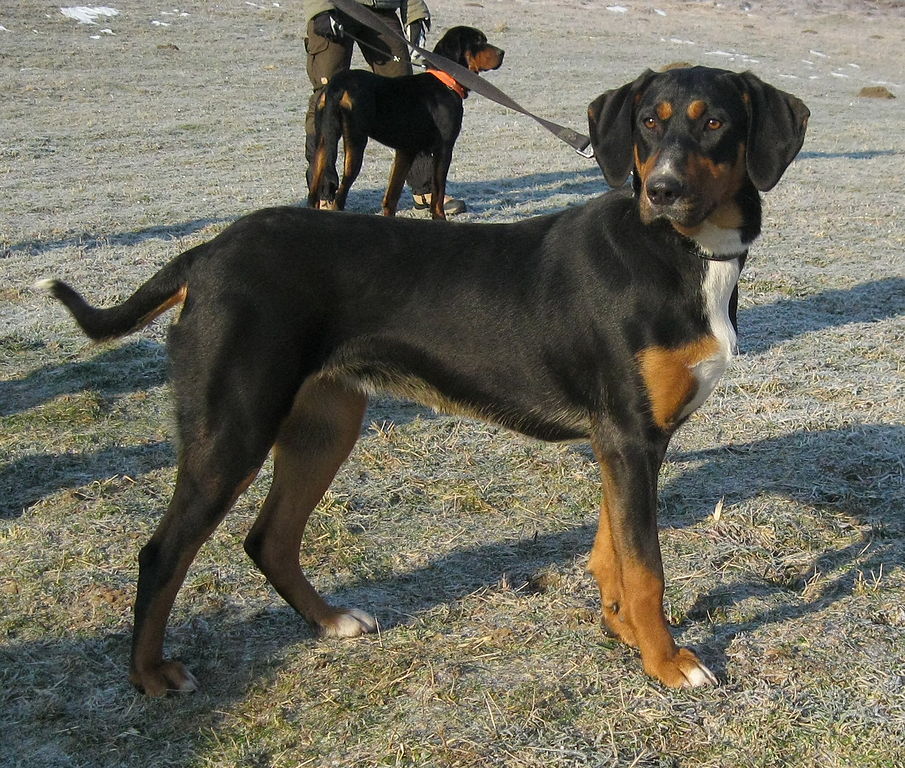 © Wikimedia.org/sajat keszites, CC0
© Wikimedia.org/sajat keszites, CC0
The Treeing Feist is a breed of feist from the Southeastern United States. Originally considered a single breed, the Mountain Feist is now considered a separate breed with both being separately recognized by the United Kennel Club. Both breeds are described as small, active, alert dogs; they have short, dense coats that can be found in any color, combination of colors or color patterns. They usually have pricked ears although semi-pricked ears are common and their tails can be docked at any length or left intact. (Source: Wikipedia.org, CC BY-SA)
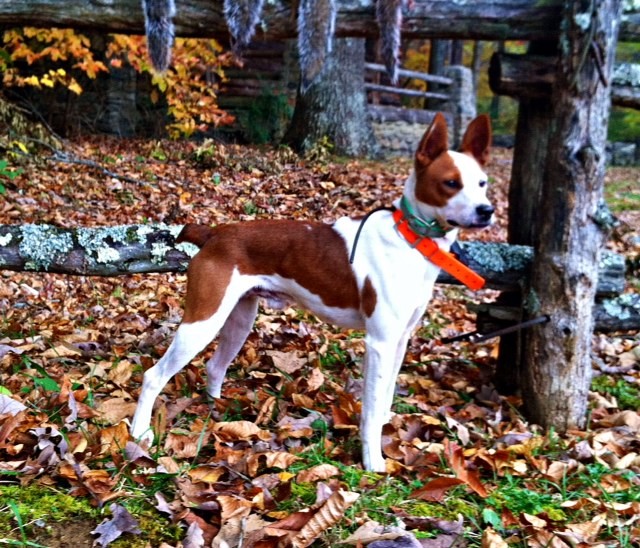 © Wikimedia.org/Atomic Feist, CC BY-SA
© Wikimedia.org/Atomic Feist, CC BY-SA
The Treeing Tennessee Brindle is a breed of cur. Since 1995, its records have been maintained through the American Kennel Club's Foundation Stock Service Program. Males stand 18 to 24 inches (46 to 61 cm) at the withers and weigh 35 to 50 pounds (16 to 23 kg), while females stand 16 to 22 inches (41 to 56 cm) tall and weigh 30 to 40 pounds (14 to 18 kg). The breed's coat is short and soft and may be either brindle or black with brindle trim. Small white markings on the chest and feet are permissible according to the breed standard, as are dewclaws. The Treeing Tennessee Brindle has a strong propensity for hunting, particularly treeing, and tends to be intelligent and fast with a keen sense of smell. Additionally, the way it bays during the hunt ('crying' or 'giving tongue') is part of the breed standard: individuals should be 'open trailers with change over at tree', and a 'coarse chop' is preferred. (Source: Wikipedia.org, CC BY-SA)
 © Wikimedia.org/Hummelong, CC BY-SA
© Wikimedia.org/Hummelong, CC BY-SA
The Treeing Walker Coonhound is a breed of hound descended from the English and American Foxhounds. The breed originated in the United States when a stolen dog known as 'Tennessee Lead' was crossed into the Walker Hound in the 19th century. The Treeing Walker Coonhound was recognized officially as a breed by the United Kennel Club in 1945 and by the American Kennel Club in 2012. The Treeing Walker Coonhound was bred primarily to hunt raccoons, but it is also used on other game such as deer, bears, bobcats or cougars. The breed is vocal with a distinctive bay that allows its owner to identify their hound from great distances. It has a clear, ringing voice that changes to a steady chop at the tree. Treeing Walker Coonhounds tend to do best in working homes. (Source: Wikipedia.org, CC BY-SA)
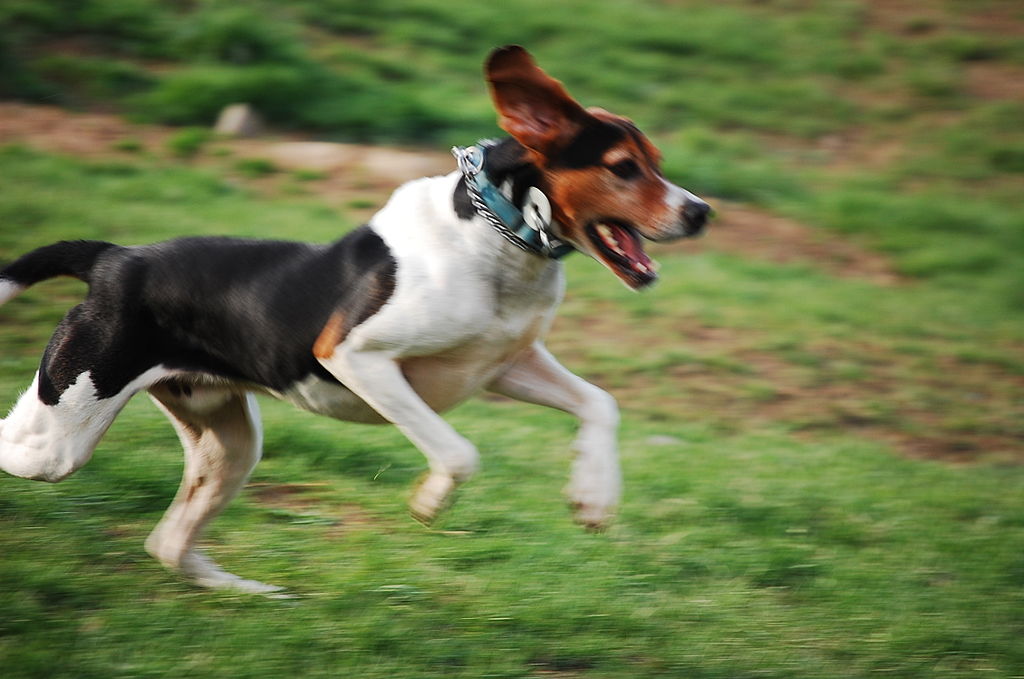 © Wikimedia.org/Kingkong954, CC0
© Wikimedia.org/Kingkong954, CC0
The Tyrolean Hound is a breed of dog that originated in Tyrol also called the Tiroler Bracke or Tyroler Bracke. They are scent hounds that descended from the Celtic hounds in the late 1800s, mainly for their hunting skills. They are hardworking, passionate, and independent dogs not known for their size, but rather their intelligence. For that reason, hunters can regularly use these dogs to catch their prey, wounded or otherwise. Their ability to stretch over long distances, on rough hot or cold terrain for their prey is also another perk of keeping this dog by your side. Hunters do have to worry about injuries to their dog, however, along with the common injuries that these dogs obtain throughout their life, like hip dysplasia or ear infections. Barring any injuries, these dogs tend to live an energetic life for about 12-14 years, and tend to be an overall healthy and robust dog. (Source: Wikipedia.org, CC BY-SA)
The Villano de Las Encartaciones is a Spanish breed of large working dog from the region of Las Encartaciones in the province of Biscay, in the Basque country; it is found also in Álava, in eastern Cantabria and in northern Burgos.: 596 The traditional use of the dogs is in management of the Monchina breed of cattle of Cantabria and the Paìs Vasco, and particularly to assist with bringing the cattle down from the mountain pastures between October and December. In 2009 there were fewer than 200 dogs registered in the studbook. Dogs stand some 57–60 cm at the withers, bitches about 55–57 cm. (Source: Wikipedia.org, CC BY-SA)
 © Wikimedia.org/Lankide gorritxiki, CC BY-SA
© Wikimedia.org/Lankide gorritxiki, CC BY-SA
The Vizsla (Hungarian: [ˈviʒlɒ]) is a dog breed from Hungary and belongs to the Federation Cynologique Internationale (FCI) group 7 (Pointing Dogs), the Canadian Kennel Club (CKC) group 1 (Sporting group), and the American Kennel Club (Sporting group). The Hungarian or Magyar Vizsla or Smooth-Haired Vizsla are sporting dogs and loyal companions. The Vizsla's medium size is one of the breed's most appealing characteristics. As a hunter of fowl and upland game, the Vizsla has held a prominent position among sporting dogs – that of household companion and family dog. The Vizsla is a natural hunter endowed with an excellent nose and outstanding trainability. It was bred to work in fields, forests or bodies of water. Although they are lively, gentle-mannered, demonstrably affectionate and sensitive, they are also fearless and possess a well-developed protective instinct. (Source: Wikipedia.org, CC BY-SA)
The Volpino Italiano or Volpino is an Italian breed of dog of Spitz type. It is closely related to the Pomeranian: 234 and to the German Spitz. The Volpino is a small dog, standing no more than about 30 cm at the withers. It is roughly square in outline, the body length more or less equal to the height. The coat is long and stands away from the body. It is either solid white or solid deep red. In the international standard a solid champagne colour is also tolerated; any other coloration is regarded as a defect. It is one of many breeds affected by hereditary primary lens luxation, an eye disease which may cause pain or blindness. (Source: Wikipedia.org, CC BY-SA)

Time for recess! Post a comment, ask a question or write a review. Feel free to let us know what you think!
Ben fransada turkce deralere girecem ehliyet ici sinavlari bilen bana yardimci olur mu
Mrhaba bu hafta yaziliya girecem bana yardimci olmak isteyen varmi isvec yazilisina cok korkuyorum yalniz
Orda tabela var otoban başlangıçı icin sorular bunlar Otoyolun başlangıçı Park etmek yasaktır Otobanın başlangıcı Giriş yapmak yasaktır Ben otobanın başlangıçı basıyom yok yanlışmiş otoyolun başlangıçıymız tabi biz türkiyede yaşıyoz unutum ben amk
Elinize sağlık Türkiye'de olmayan birçok levha var.Mantık yürüterek dogru cevapları bulmaya çalıştım.
Gercekten emeginize saglık. Alakasız ve yanlıs birsürü testle karşılaştım, sonunda faydalı bir sayfaya denk geldim.
Merhaba benim Türk ehliyetim var Romanya ehliyeti ile değiştirmek istiyorum nasıl yapabilirim
Dun sinava girdim tek bir soruyla kaybettim dogru bildim konturol ettim 3 soruyu yannis ciklarla cevirdim
HAZIRLAYANLARDAN ALLAH RAZI OLSUN IN$LLH COK GÜZEL-TEK SIKINTI COK AZ TÜRKCE CEVIRIMLERDE AMA OLSUN BEN COK BEGENDIM TE$EKKÜRLER
Bazı sorularda yazımı da aynı olan 2 aynı doğru cevap var. Örnek: Yayalar için yolun sonu. Yerleşim alanının sonu. Bir yerleşim alanının başlangıcı. Yerleşim alanının sonu.